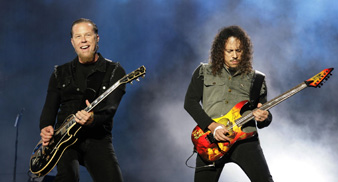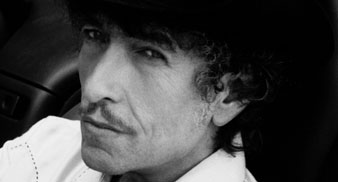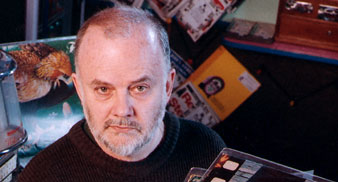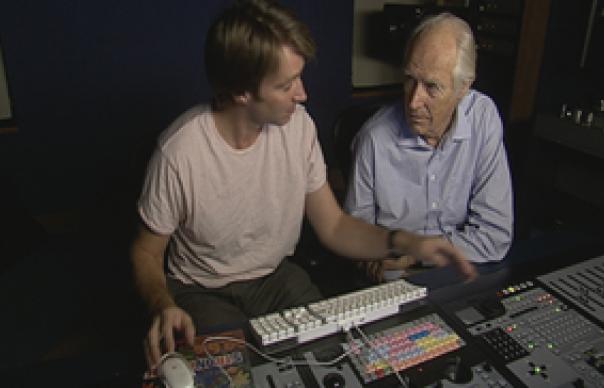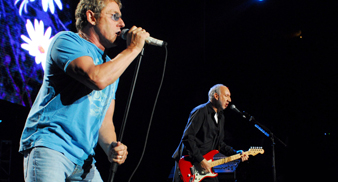BOB DYLAN SPECIAL: The Complete Tell Tale Signs
In this month’s issue of Uncut, we celebrate the release of Tell Tale Signs, the Bootleg Series Vol 8, Bob Dylan’s astonishing 2 and 3CD collection of unreleased material from 1989-2006.
We spoke to the musicians, producers and crew who worked with him during this period. And now, here’s your chance to read the full, unedited transcripts of those interviews.
Today, we present part 8; Jim Dickinson‘s story about working on Time Out of Mind, while Daniel Lanois, Jim Keltner and others will follow in a further five parts in the coming weeks.
You can read previous transcripts by clicking on the side panel (right).
Next one up Friday (October 17)!
****
JIM DICKINSON
Out of Memphis, the great rock’n’roll pianist and producer played on the Stones’ “Wild Horses” and was another of the Wild Bunch of veterans Dylan recruited for Time Out Of Mind.
The biggest problem recording Time Out Of Mind was the set-up; there were like twelve musicians live on the floor, three full drumkits. But, once the logistics of that were worked out, the way Dylan presented the songs to us was very traditional. He would play a song to us acoustically, and then we would start to get a groove. And, generally speaking, we took the first cut. Sometimes we would make multiple cuts, maybe two or three, but then he’d go back to the first one and select that. He was definitely into the spontaneity of the moment.
I think he’s distrustful of the recording process. He doesn’t give things time to develop in a traditional fashion. He wants the first interpretation he can get of the song. I saw the same thing working with The Rolling Stones, where they were interested in the moment of creation. Keith Richards said, “That’s where the song comes alive, the first performance.” Alex Chilton was the same way.
With Dylan, I mean, there was an *awful lot* of music going on. Six guitar players, y’know, people just sitting there ready to play. And barely able to get a note in. It was a curious situation. Sometimes, when it was all going on, it would be chaotic, for an hour or more. But then there would be this period of clarity, just five or eight minutes of absolute clarity, where everybody in the room knew we were getting it. It was unlike any session that I’ve ever been on. Because everybody could feel the potential, and realising that potential – if we went too far, it *was* too far. If we did too much, we would kill whatever it was that he wanted.
In the case of these outtakes that are about to come out, the two that I played on, “Mississippi” and “Girl From The Red River Shore”, they represented the most conflict in the studio between Dylan and [producer] Daniel Lanois. In the case of “Mississippi”, there was a cut that we had that was very swampy, a real kind of early’70s feeling that Lanois really liked. And it just wasn’t the direction that Dylan wanted to go. I think it was too obvious for him. And the two of them really got into it over that one.
“Girl From The Red River Shore” I personally felt was the best thing we recorded. But as we walked in to hear the playback, Dylan was walking in front of me, and he said, “Well, we’ve done everything on that one except call the symphony orchestra.” Which indicated to me that they’d tried to cut it before. I was only there for ten days, and they had tried to cut some songs earlier that didn’t work. If it had been *my* session, I would have got on the phone at that point and called the fucking symphony orchestra. I’ll be very curious to hear that song again after all this time, I was very impressed by that particular cut. But, when he selects the material that’s going to make up a record, Dylan is notorious for leaving off what appears to be the best one.
One thing that really struck me during those sessions, Dylan, he was standing singing four feet from the microphone, with no earphones on. He was listening to the sound in the room. Which is the sound that *did not* go on the record. I truly never saw anything like it. And yet, he was in unspoken control of twenty-three people. Aside from the conflict between him and Lanois, there was an utter oneness as far as the direction of the session was concerned.
The way I heard it when I got there, when they’d first started out on the record, Lanois had wanted to record as a trio, in Oxnard. And they had started doing it, and then Dylan pulled the plug on it, and then he found the Criteria studio in Miami himself. (Ironically, my group the Dixie Flyers, were booked to record with Dylan at Criteria in 1970 – and his manager Albert Grossman pulled the plug on that, so it never happened. So, for me, it was coming back around, 30 years later.)
Bob had, for want of a better word, an orchestral concept: this thing of too many instruments in the room. There was chordal tension. It’s really hard to describe. There were three different sounds going on: there was the sound of what was in the room, there was what we heard in our earphones, and then there was what we heard at playback, and those were three very different things. The engineer Mark Howard was recording with a lot of effects, printing them to tape, and they took at least three of the playbacks from the initial night, and those were the final mixes. It really wasn’t like anything else I’d ever done.
Did Dylan say much about the kind of sound he was after? He said almost nothing. Almost nothing. Until we after we’d got something, and then he’d discuss it. But it was very abstract, very either/ or. Either he liked it, or he didn’t like it, there was no grey middle ground for him.
He’s a better guitar player than I ever would have thought. Much more fluid, hitting various keys, whatever. Although there are six guitarists on that session, the two that you’re hearing, mostly, are Dylan and Lanois. The kind of slower, looser Hendrix licks that you hear, that’s Dan. And the stuff that sounds like Jerry Garcia, that’s Dylan. On “Mississippi”, there was a guitar line that Dylan was developing that didn’t really get developed, and I think that was part of the conflict over that, he didn’t think that line was being dealt with. Actually, I’m not sure what he didn’t like about it.
But the cut of “Red River Shore” was amazing. You couldn’t even identify what instruments were playing what parts. It sounded like ghost instruments. And the song itself is really remarkable. It’s like something out of the Alan Lomax songbook, a real folk song. But, like I said, I gather it wasn’t the first time he had tried it. And, again, to compare him to Alex Chilton, after you did a song with Alex three or four times, he was past it. One of the things you really don’t want to hear on a record is boredom. And, while, certainly, no one was bored by playing with Bob Dylan, once they did fall into playing repetitious parts, I think that had that same effect on him.
He’s a consummate professional. This may seem like a small thing, but I was impressed by the fact that he had hand-written lyric sheets. Y’know, on, like, notebook paper, like he’d done it in study hall. He said he’d been working on some of the songs for five or six years. And he was still working on lyrics as we were cutting. He had a guitar tech who had all these steamer chests full of gear, and Dylan would lean over this one particular chest and work on his lyrics. With a pencil – because he was erasing stuff. That really touched me to see that. Y’know, you see so many artists come in with their Xeroxed copy that their roadie printed-off. But this was very personal, as far as the songs were concerned. I think it is all about the songs for him.
The other thing about his actual performance in the studio that surprised me, was how loud his voice is. How powerful. I did a record with Toots Hibbert a few years ago, and he did that same thing – literally stood four feet from the microphone, and he wasn’t in a booth, he was live out in the room. You’ve got to have some voice to do that.
I don’t want to give the impression that Dylan was awkward in the studio, it’s more that he was reluctant. Until he reached a point where he trusted, musically, what was happening, then it *didn’t *happen. But, on most of the songs, when we got into the intro, you could tell that he had it, that this was it. Everybody better come across now.
And some of the musicians that were on the session! Jim Keltner is a god of music, and of course, playing his heart out, because he would do anything for Dylan. Bob Britt’s probably the number one call in Nashville. Duke Robillard was just sitting there holding his guitar, waiting for a place to play a note. And I’ve never in my life before or since seen two pedal steel guitars played simultaneously, not even on hillbilly sessions. And Cindy Cashdollar, she wrote the book. Literally. You go find the book: she wrote it! There were some amazing musicians. And Augie Meyers, as well, he goes back with Bob, too, to the early 60s. There was a lot of heart in the room. And a lot of a people of a certain age. There was a lot of mortality there. And, y’know, it was truly the ambition of my career.
There is for sure something about the recording process that makes Dylan uncomfortable. I think it might have something to do with his own personal history. I think, maybe, some of his stuff he’s been dissatisfied with, and has felt manipulated. I mean, it’s curious to even say the words: that someone could manipulate Bob Dylan. But I saw them try during those sessions. I mean, management would talk to him about the radio. Can you imagine talking to Bob Dylan about *getting on the fucking radio*? And yet, they did. And they almost acted like they thought they were fooling him. But my humble opinion – when you’re on a Bob Dylan session, you should be on the page with Bob Dylan.
I remember, when we finished “Highlands” – there are two other versions of that, the one that made the record is the rundown, literally, you can hear the beat turn over, which I think Dylan liked. But, anyway, after we finished it, one of the managers came out, and he said, “Well, Bob, have you got a short version of that song?” And Dylan looked at him and said: “That *was* the short version.”
I mean, I don’t understand how people can presume to fuck with *Bob Dylan*. Yet they do. I mean, who do they think they are, compared to this man? My God. Dylan has a reputation of appearing and disappearing, y’know, of all of a sudden being in the room, and all of a sudden being gone. And he was doing that. Actually, I caught him at it, because I know Criteria pretty well. Yeah, he’ll definitely screw with your head, but, y’know – who can blame him? When they picked me up at the airport, on the way back to the studio, one of the bodyguards was telling me, y’know, “Don’t look at him, don’t talk to him,” all that stuff. And the first night, I don’t even know if we’d done a song, I was standing out in the parking lot smoking a joint, and here he comes, “Hey, didn’t you used to play with Sleepy John Estes?” What was I supposed to do? Say no? So, I did see him cut people off, and ignore people, as you’ll hear that he does. But he didn’t with me. He talked to me the whole time. In fact, it pissed Lanois off: “They said he talks to you, he doesn’t talk to me. He thinks I’m a whippersnapper!”
The thing I really noticed, in terms of their trying to put pressure on Dylan, all the songs on Time Out Of Mind are kind of pitched low. It’s all low in his vocal register. And, apparently, early in the session, whether it was when they were doing the trio, or when he was just playing acoustic guitar, he had some of the songs pitched in a higher register. But he very definitely avoided that while I was there. I saw Lanois try to manipulate Dylan into the higher register, and I saw Dylan resist it.
Dylan didn’t have anything favourable to say about the earlier versions of the songs. First, before the trio thing, I think they tried to do a just-sit-around-and-strum kind of thing. But Dylan, apparently, said, “No. I’ve already done that.” He was clearly interested in doing something he hadn’t done before. And I think in many ways Time Out Of Mind was his resolution with Lanois over Oh Mercy. I think there were issues unresolved over Oh Mercy that he was determined to resolve.
Bob definitely knows what he’s doing, beyond any question of a doubt. People who say that it’s all just off the cuff and improvised, they just don’t get it. I think it says something that, since Time Out Of Mind, he’s more or less chosen to produce himself. I’m not sure what it says, though. Production is for sure a part of the process that he doesn’t trust, but I personally think that self-production is a myth. There are many who have tried it. I don’t think he has really made a complete record since Time Out Of Mind, either. I mean, I have issues with the mix on Time Out Of Mind, but, other than that, that’s a *monster* of a record.
I don’t mean to criticise Bob here, God knows, but I think self-production is a myth, and he’s denying himself the luxury of a relationship that can be good. He’s obviously had problems with producers, without doubt. That would be my response to what I saw in the studio. But, y’know – as a producer – I’m ready for the phone to ring at any moment. Like I said, if *I* had been producing that night on “Girl From The Red River Shore”, I would have called the symphony orchestra. Because, believe me, they have one in Miami. And they would be delighted to play for Mr Dylan.
DAMIEN LOVE


